It is the factory stamp or trademark of Bing & Grondahl, the Danish porcelain manufacturer, that helps determine the age of any porcelain item made by Bing & Grondahl.
The porcelain factory Bing & Grondahl was established 19th April 1853 by Vilhelm Grondahl and the brothers Meyer and Jacob Herman Bing, who where book and art dealers.
About the Three Towers
Bing & Grondahl is not quite as old as Royal Copenhagen and therefore Bing & Grondahl has had a stamped mark under the bottom right from the beginning in 1853.
Until 1898, the Bing & Grondahl brand simply consisted of B&G stamped in blue. Bing & Grondahl then chose the three towers as it's factory brand. The three towers are from the coat of arms of Copenhagen, showing the three towers of the castle of Absalon. The three towers have always been stamped in green. However, they continued to stamp with B&G in blue up to and including 1947.
The factory mark symbolizes Bing & Grondahl's connection to Copenhagen and the three towers have become synonymous with Bing & Grondahl in the same way that the three waves have become synonymous with Royal Copenhagen.
The trademark development from 1853
Please use the overview below to determine the age of your porcelain by Bing & Grondahl.

1853-1897
B&G mark in blue.

1898-1899
The three towers, B&G Copenhagen Danish China Works stamped in green and B&G in blue.

1899-1902
The three towers, B&G Kjøbenhavn Danish China Works stampes in green and B&G in blue.

1902-1914
The three towers, B&G Kjøbenhavn Made in Denmark stamped in green and B&G in blue.
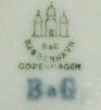
1914-1915
The three towers, B&G Kjøbenhavn Copenhagen stamped in green and B&G in blue. This mark overlaps with the mark that ended in 1914 and the one that began in 1915.

1915-1947
The three towers, B&G Kjøbenhavn Danmark stamped in green and B&G in blue.

1948-1951
The three towers, B&G Kjøbenhavn Danmark and B&G in green.
1952-1957
The three towers, B&G Kjøbenhavn Made in Denmark stamped in green.

1958
The three towers, B&G Kjøbenhavn Made in Denmark stamped in green.
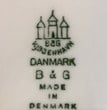
1959-1960
The three towers, B&G Kjøbenhavn, DANMARK B&G Made in Denmark stamped in green.

1961-1965
The three towers, B&G Kjøbenhavn Made in Denmark stamped in green.

1966-1969
The three towers, B&G Kjøbenhavn DENMARK stamped in green.


1970-1982
The three towers, B&G, Copenhagen Porcelain Made in Denmark round mark in green, or The three towers, and B&G in Blue print.
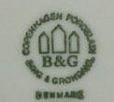
1983-2004
The three towers, B&G, Copenhagen Porcelain Bing & Grøndahl, Denmark stamped in green. This mark was used on Bing & Grondahl products until 1987, when the factory was merged with Royal Copenhagen. After 1987 it was only B&G Annual collectibles that continued with the three towers.
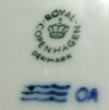
1987
Royal Copenhagen's mark was used on B&G products after the merger in 1987 only excluding the Annual collectibles. Thus the B&G products produced after 1987 had the mark of Royal Copenhagen.
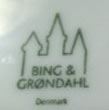
2005-now
The three towers, BING & GRØNDAHL Denmark stamped in green. Only used for Annual collectibles.
Major Changes to the Factory Mark
In general, there are some periods that you can quickly relate to when determining age for Bing & Grondahl porcelain. If you only have B&G in blue, then it is before 1898, if there are both the three towers and B&G in blue, then it is the period between 1898 and 1947.
From 1948, only the green mark with the three towers was used, but it had a significant change in style in 1970, which is why it is easy to differentiate. If it is the old towers without a blue B&G stamp, then it is between 1948 and 1969. From 1970 to 2004 a round stamp with three highly stylized towers was used. And from 2005 until today there have been three towers and BING & GRØNDAHL.
With these clear characteristics, Bing & Grondahl can be roughly sorted into periods, then you can use the above list to get closer to the fabrication period.
Royal Copenhagen Mark on Bing & Grondahl Porcelain
Curiosly, products that are Bing & Grondahl products can also be mark with the three waves of Royal Copenhagen, if they continued to be in production after 1987.
When Bing & Grondahl and Royal Copenhagen merged in 1987, both factories were marketed under the Royal Copenhagen name, which is why the remaining Bing & Grondahl products continued under the Royal Copenhagen brand.
An excellent example of this is the Else figurine, which was originally a Bing & Grondahl figurine, but is very well known as a Royal Copenhagen figurine around the world. It is only Bing & Grondahl's Christmas plates and other annual articles that continued to have the Bing & Grondahl mark.
Don't miss free tips and a lot of great sales
DPH Trading
Løkkegravene 49
5270 Odense N, Denmark
CVR-no.: DK61086013
Follow us on social media:

 We are e-approved
We are e-approved






